You are here
-
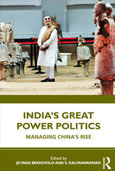
- Publisher: Routledge India
2021
This book examines India’s foreign and defence policy changes in response to China’s growing economic and military power and increased footprint across the Indo-Pacific. It further explores India’s role in the rivalry between China and the United States.The book looks at the strategic importance of the Indian Ocean Region in the Indo-Pacific geopolitical landscape and how India is managing China’s rise by combining economic cooperation with a wide set of balancing strategies. The authors in this book critically analyse the various tools of Indian foreign policy, including defence posture, security alignments, and soft power diplomacy, among others, and discuss the future trajectory of India’s foreign policy and the factors which will determine the balance of power in the region and the potential risks involved.
The book provides detailed insights into the multifaceted and complex relationship between India and China and will be of great interest to researchers and students of international relations, Asian studies, political science, and economics. It will also be useful for policymakers, journalists, and think tanks interested in the India–China relationship.
- ISBN: 9781032045955 ,
- Price: ₹ 995.00
- Publisher: Routledge India
-

- Publisher: Springer
2021
This book is about the strategic relevance of quantum technologies. It debates the military-specific aspects of this technology. Various chapters of this book cohere around two specific themes. The first theme discusses the global pattern of ongoing civilian and military research on quantum computers, quantum cryptography, quantum communications and quantum internet. The second theme explicitly identifies the relevance of these technologies in the military domain and the possible nature of quantum technology-based weapons. This thread further debates on quantum (arms) race at a global level in general, and in the context of the USA and China, in particular. The book argues that the defence utility of these technologies is increasingly becoming obvious and is likely to change the nature of warfare in the future.- ISBN: 978-3-030-72720-8 ,
- Price: EUR 89.99
- Publisher: Springer
-

- Publisher: KW Publishers
2021
This book attempts to provide a comprehensive understanding of the circumstances which have shaped India’s approach towards its international borders and the framework it has developed to better manage its borders. The book argues that persistence of various cross-border threats and challenges and an absence of robust intra-regional trade among its neighbouring countries forced India to employ a security-centric and unilateral approach to border management with emphasis on hardening the borders to cross-border trade and travel and keeping the border areas underdeveloped to act as a buffer against external conventional threats. However, as India’s economy grew and the country gained more confidence and resources, India started perceiving the borders as bridges rather than barriers. Consequently, greater emphasis was being laid on development of border areas and restoring severed lines of communication with its neighbours through increased investments in building transportation networks both within the border as well as beyond. It also started constructively engaging its neighbours to effectively manage its international borders. Besides discussing the threats and challenges that India faces along the borders, the book aims to develop an understanding of India’s border management practices by analysing various programmes and initiatives such as the raising of border guarding forces; building of physical and electronic fences; the establishment of modern facilities for smoothening legitimate cross-border travel; the development of the border areas through special programmes; and increasing trade and connectivity as well as other cooperative bilateral mechanisms.- ISBN: 9789391490003 ,
- Price: ₹. 1088/-
- Publisher: KW Publishers
-

- Publisher: Routledge
2021
This book is a study of India’s political, diplomatic and security challenges caused by the changing geopolitical and security dynamics in the Middle East and North Africa (MENA) region. Like many other countries, India has been deeply affected by the unrest in the Arab world. As India has several long-term economic, political and security stakes in the region, it has adopted extreme caution in its responses towards the developments in the MENA region since the beginning of the Arab unrest. This book examines India’s policy of non-intervention and opposition to military intervention in the internal and regional affairs of the MENA region. In response to the ongoing conflict, India has engaged with several regional organisations and multilateral forums to work together and find political solutions to the regional conflicts. The book also examines new developments, such as the rise of the Islamic State, and the new security challenges this has introduced. Despite the regional turbulences, the momentum of India’s engagements with the countries of the region has been maintained and India has been building mutually beneficial partnerships in diverse fields. In this context, the book examines the response, approach and the policies India has adopted to protect and promote its interests during the last ten years of unrest.- ISBN: 9780367618506 ,
- Price: £96.00
- Publisher: Routledge
-
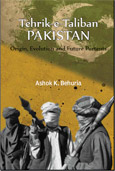
- Publisher: KW Publishers
2021
This volume is a result of an abiding interest in the phenomenon of radical Islamist terror that haunts Pakistan today. The research questions that it seeks to answer are: Why do the tribal areas remain a problem for rulers and administrators throughout history? How and why did radical Islam embed itself in the terrain?Was it influenced by the overall emphasis on Islam in Pakistani state politics? What is the role of history and politics in fuelling religious passions in the area? What has led to the survival of TTP despite humongous efforts of the Pakistan Army to decimate it? What are the future portents of such a movement? What impact is it likely to have on Pakistani society and politics?
The volume makes an attempt to understand the context in which Pakistani Taliban or TTP, as it is called now, came into being, the enabling factors that made the growth of TTP possible, the formation and growth of TTP as a militant organisation, its leadership and its activities over the years, its ideological orientation and its worldview, its aims and objectives, its relationship with other militant groups in and outside Pakistan and the efforts of the Pakistani establishment to come to terms with such a phenomenon. There is an attempt to analyse the process and study its implications for Pakistan and the region.
- ISBN: 978-93-91490-02-7 ,
- Price: ₹. 880/-
- Publisher: KW Publishers
-
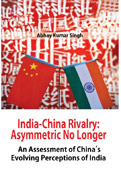
- Publisher: KW Publishers
2021
In recent years, there has been growing interest in deciphering the nature and contours of bilateral dynamics between India and China, since the contours bilateral dynamics between the two rising powers have potential implications for the evolving geopolitical order in the region and even beyond. This book is not about understanding the nature of rivalry dynamics between India and China but prominently focuses on China’s mental and emotional image of India, which has remained an underexplored dimension in contemporary scholarship.The aim of the book is two-fold. First, this book is an effort to analyse China’s contemporary perceptual image about India primarily through the analysis of Chinese publications on the subject. Second, this book questions the prevalent notion of characterising India-China rivalry as ‘one-sided’ or ‘asymmetric.’
Unarguably, power asymmetry, with substantial Chinese advantage, has been a persistent characteristic of India-China relations and is likely to remain or even grow further. India, being weaker in this dyad, naturally has a greater threat perception vis-à-vis China. However, this apparent power asymmetry does not provide China with an overwhelming advantage over India.
The book argues that India has been and continues to be a ‘strategic rival’ in Chinese perception even though it is not categorised by China as its ‘principal rival.’ In the contemporary period, as India expands its defence capabilities, extends its regional outreach and deepens its engagement with major powers, Beijing has begun to factor New Delhi into its strategic calculus even more seriously.
- ISBN: 978-93-91490-01-0 ,
- Price: ₹. 980/-
- Publisher: KW Publishers
-

- Publisher: KW Publishers
2021
Defence reforms are a challenge for most countries. The lessons from India’s experience suggest that major change has almost always been mandated from the very top. The ongoing structural changes are also being driven by the highest political office in a bid to seek integration, indigenisation and greater effectiveness of the armed forces.The ongoing military reforms began with the appointment of the Chief of Defence Staff (CDS) and creation of the Department of Military Affairs. Future changes are likely to include the creation of theatre commands, functional commands, restructuring of Army Headquarters and a number of other associated shifts in conjunction with these big bang reforms.
It would not be an exaggeration to say that these changes are perhaps the most far-reaching military reforms in India’s post-independence history.
The book undertakes a focussed assessment of the changes that commenced with the appointment of CDS. This includes the role and inter-se co-relation between major stake holders and defence departments. Keeping in view the need to enhance operational effectiveness, recommendations regarding the chain of command, rank structures and role of service chiefs have been made. The book will also analyse the structure and role of the future Air Defence and Logistics Command.
- ISBN: 978 819 52 858 4 6 ,
- Price: ₹. 918/-
- Publisher: KW Publishers
-
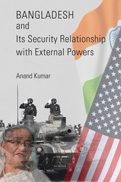
- Publisher: KW Publishers
2021
A state’s security is heavily dependent upon its geopolitical environment. The geopolitical setting of South Asia changed in 1971 with the birth of Bangladesh as a new, independent nation. India already faces a hostile neighbour on its western border. In the north, China is a major threat. In this geopolitical setting the kind of relationship India has developed with Bangladesh becomes important.The military coup of August 1975 in Bangladesh marked a major shift in the way the country perceived its foreign and defence policies. India, its supporter in the liberation war, was now presented as the main threat to national security. A country’s defence policy and defence-related procurements depend on the threat perception of that country. Bangladesh, despite being a poor country, has tried to acquire significant defence capability mainly due to its perceived sense of insecurity and to some extent to participate in the United Nations peacekeeping operations. Some of the steps taken by Bangladesh purportedly to enhance its own security have meant that the security environment in the region has actually deteriorated. In this context Bangladesh’s security relationship with other major powers has significant implications for Indian security, and the book tries to throw light on it.
- ISBN: 978 93 91490 15 7 ,
- Price: ₹. 980/-
- Publisher: KW Publishers
-
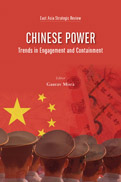
- Publisher: KW Publishers
2021
The East Asia Strategic Review is an annual publication of the East Asia Centre, Manohar Parrikar Institute for Defence Studies and Analyses (MP-IDSA), New Delhi. The current volume titled "Chinese Power: Trends in Engagement and Containment" intends to present an Indian perspective on China's strategic outreach in the East Asian region under President Xi Jinping. It analyses how Beijing employs the instruments of diplomacy, economy, military and political outreach to engage with the regional countries and how US presence influences the regional dynamics.- ISBN: 978-3-030-72721-5 ,
- Price: EUR 74.89 [ebook] | EUR 89.99 [Hardcover]
- Publisher: KW Publishers
-

- Publisher: Palgrave Macmillan
2021
This book is a comprehensive study on the education system of Saudi Arabia, placing the reforms and changes it has undergone in the past two decades within the context of the historical evolution of the education system. An education system cannot be seen in isolation of the society; it plays a significant role in shaping the individual, state and the society, that in turn, have a bearing on the education system and its evolution. Therefore, this book locates Saudi education in the backdrop of the changes in the society, how they have facilitated or hindered the education reforms and how the education reforms have impacted the society. The book does not ignore the immediate trigger for the beginning of a comprehensive reforms process but goes beyond it to find much deeper socio-political and economic rationales that paved the way for the reforms. It provides a nuanced understanding of the interplays of various socioeconomic as well as political factors that have shaped the education system in Saudi Arabia.- ISBN: 978-981-15-9172-3,
- Price: 84,99 €
- Publisher: Palgrave Macmillan
